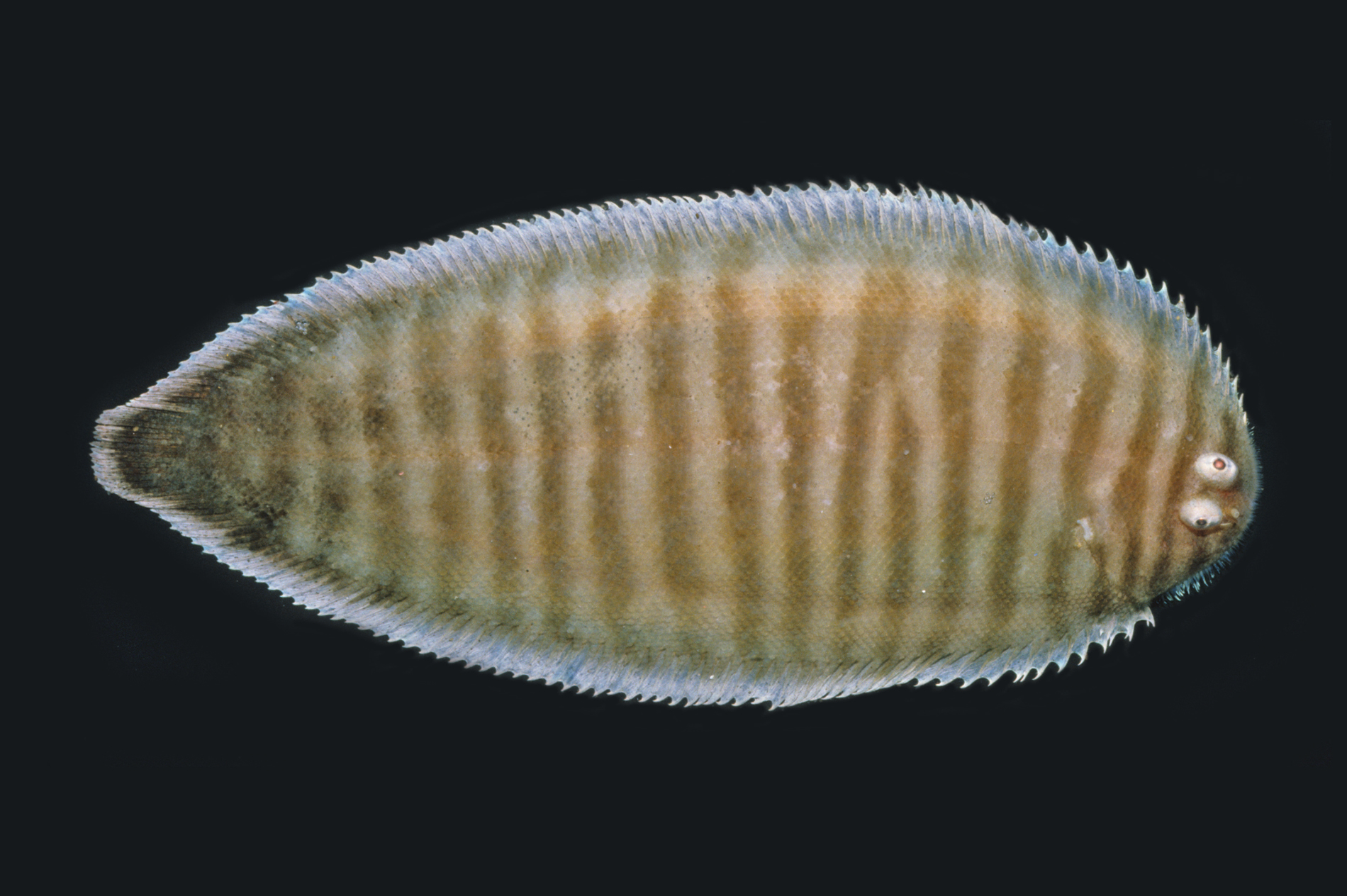Manyband Sole, Zebrias scalaris Gomon 1987
Other Names: Many-band Sole, Manybanded Sole, Many-banded Sole

Manyband Sole, Zebrias scalaris. Source: Rudie H. Kuiter / Aquatic Photographics. License: All rights reserved
Summary:
A pale brown sole with 16-24 darker almost parallel bands across the body and caudal-fin base, bands of equal width or slightly narrower than pale interspaces and usually distinct, though not sharply demarcated from interspaces.
Cite this page as:
Bray, D.J. 2024, Zebrias scalaris in Fishes of Australia, accessed 27 Jun 2025, https://fishesofaustralia.net.au/Home/species/1018
Manyband Sole, Zebrias scalaris Gomon 1987
More Info
|
Distribution |
Endemic to south-eastern Australia from Fraser Island, Queensland, to Great Oyster Bay, Tasmania, and Port Phillip, Victoria. Inhabits soft bottom areas in coastal waters, bays, harbours and estuaries. |
|
Features |
Dorsal fin 75-82; Anal fin 60-69; Lateral-line scales 74-86. Eyes separated by narrow scaly, interorbital space. Pectoral fins rudimentary, of similar size and form, continuous with opercular membrane to a form short tubular structure; length of rays less than half eye diameter. |
|
Size |
Reaches a length of 200 mm. |
|
Colour |
Pale with 16-24 parallel darker bands crossing body and base of caudal fin, bands of equal breadth or slightly narrower than interspaces and usually distinct, though not sharply demarcated from interspaces. |
|
Fisheries |
May be taken as bycatch in prawn trawl fisheries. |
|
Similar Species |
The similar Duskybanded Sole, Zebrias penescalaris, differs from Z. scalaris in having fewer lateral-line scales (67-76, vs 79-86 in Z. scalaris, one specimen with 74 scales), generally fewer dorsal-fin rays (70-76, vs 75-82 in Z. scalaris, one specimen of Z. penscalaris with 80 scales), and less definition in the body banding. |
|
Etymology |
The specific name is from the Latin scalaris (= ladder), in reference to the rung-like bands traversing the body. |
|
Species Citation |
Zebrias scalaris Gomon 1987, Mem. Mus. Vict. 48(1): 21. Type locality: Port Jackson, New South Wales. (Replacement name for Synaptura fasciata Macleay 1882, secondarily preoccupied in Zebrias by Solea fasciata Basilewsky 1855. |
|
Author |
Bray, D.J. 2024 |
|
Resources |
Manyband Sole, Zebrias scalaris Gomon 1987
References
Gomon, M.F. 1987. New Australian Fishes. Part 6. New species of Lepidotrigla (Triglidae), Choerodon (Labridae) and Zebrias (Soleidae). Memoirs of Museum Victoria 48(1): 17-23 fig. 1. https://doi.org/10.24199/j.mmv.1987.48.06
Gomon, M.F. 1994. Family Soleidae. pp. 860-865, figs 761-763 in Gomon, M.F., Glover, C.J.M. & Kuiter, R.H. (eds). The Fishes of Australia's South Coast. Adelaide : State Printer 992 pp. 810 figs.
Gomon, M.F. 2008. Family Soleidae. pp. 817-821 in Gomon, M.F., Bray, D.J. & Kuiter, R.H. (eds). Fishes of Australia's Southern Coast. Sydney : Reed New Holland 928 pp.
Gray, C.A., Kennelly, S.J. & Hodgson, K.E. 2003. Low levels of bycatch from estuarine prawn seining in New South Wales, Australia. Fisheries Research 64: 37-54.
Gray, C.A., Kennelly, S.J., Hodgson, K.E., Ashby, C.J.T. & Beatson, M.L. 2001. Retained and discarded catches from commercial beach-seining in Botany Bay, Australia. Fisheries Research 50: 205-219.
Johnson, J.W. 2010. Fishes of the Moreton Bay Marine Park and adjacent continental shelf waters, Queensland, Australia. pp. 299-353 in Davie, P.J.F. & Phillips, J.A. Proceedings of the Thirteenth International Marine Biological Workshop, The Marine Fauna and Flora of Moreton Bay. Memoirs of the Queensland Museum 54(3)
Kuiter, R.H. 1993. Coastal Fishes of South-eastern Australia. Bathurst : Crawford House Press 437 pp.
Last, P.R., Scott, E.O.G. & Talbot, F.H. 1983. Fishes of Tasmania. Hobart : Tasmanian Fisheries Development Authority 563 pp. figs. (as Zebrias fasciatus)
Macleay, W.J. 1882. Notes on the Pleuronectidae of Port Jackson with descriptions of two hitherto unobserved species. Proceedings of the Linnean Society of New South Wales 1 7(1): 11-15 (described as Synaptura fasciata, type locality Port Jackson, New South Wales)
Munroe, T.A. 2001. Soleidae, Cynoglossidae. pp. 3878-3901 in Carpenter, K.E. & Niem, T.H. (eds). The Living Marine Resources of the Western Central Pacific. FAO Species Identification Guide for Fisheries Purposes. Rome : FAO Vol. 6 pp. 3381-4218.
Munroe, T.A. 2021. Zebrias scalaris. The IUCN Red List of Threatened Species 2021: e.T158881223A158881699. https://dx.doi.org/10.2305/IUCN.UK.2021-2.RLTS.T158881223A158881699.en. Accessed on 06 March 2024.
Norman, J.R. 1926. A report on the flatfishes (Heterosomata) collected by the F.I.S. Endeavour, with a synopsis of the flatfishes of Australia and a revision of the subfamily Rhombosoleinae. Biological Results of the Fishing Experiments carried on by the F.I.S. Endeavour 1909-1914 5(5): 219-308 figs 1-15 (as Brachirus fasciatus)
Stephens, H.R. 2010. Taxonomic revision of the flatfish genera Zebrias Jordan and Snyder, 1900 and Pseudaesopia Chabanaud, 1934 with notes on Aesopia Kaup, 1858 (Pleuronectiformes: Soleidae). unpublished PhD thesis. pp. i-xix, 1-290, figs
Whitley, G.P. 1964. A survey of Australian Ichthyology. Proceedings of the Linnean Society of New South Wales 89(1): 11-127 (as Haplozebrias fasciatus)




